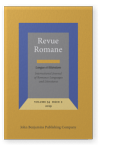Articles Linguistiques
Degrees of grammaticalization and measure constructions in Italian
Against the background of recent debate on Grammaticalization Theory, this study will provide an overview of some Italian
quantifying expressions whose original head is a measure noun. The binominal expressions analysed indicate a quantity, either
large or small; as such, they can be substituted by canonical quantifiers such as molto “much” or un
po’ “a little”. I claim that their functioning as quantifier is the result of a process of grammaticalization,
through which the original head noun of the complex construction has been reanalysed as quantifier. At a closer look, however, the
degrees of grammaticalization appear different for specific items, as well as the sources providing the recruitment of new
quantifiers. The specific collocational patterns that trigger the pragmatic inferences prior to their semanticization and
reanalysis have not as yet received sufficient attention. Adopting a diachronic Construction Grammar approach, the paper discusses
various case studies and provides a number of descriptive and theoretical insights concerning the rise of distinct
grammaticalization patterns.
Article outline
- 1.Introduction
- 2.Theoretical and methodological questions
- 3.The construction un sacco di between lexical uses and grammaticalization paths
- 4.Other size nouns reanalyzed as quantifiers
- 4.1
Un mucchio di
- 4.2
Un monte di, una montagna di “a mountain of”, “a heap of”
- 4.3
Un mare di / una marea di
- 4.4
Una valanga di
- 4.5A look at historical attestations
- 5.Small size nouns
- 5.1
Briciolo and briciola
- 5.2Further cases
- 6.Conclusions
- Notes
-
References
References
Aarts, B.
(
1998):
Binominal noun phrases in English.
Transactions of the Philological Society, 961, pp. 117–158.


Barðdal, J., E. Smirnova, L. Sommerer & S. Gildea
Brems, L.
(
2007):
The grammaticalization of small size nouns. Reconsidering frequency and analogy.
Journal of English Linguistics. 34 (4), pp. 293–324.


Brems, L.
(
2010):
Size nouns constructions as collocationally constrained constructions: Lexical and grammaticalized uses.
English Language and Linguistics, 14.1, pp. 83–109


De Clerck, B. & T. Colleman
(
2013):
From noun to intensifier: massa and massa’s in (Flemish) varieties of Dutch.
Language Sciences. 361, pp. 147–160.


De Clerck, B. & L. Brems
(
2016):
Size noun matter: a closer look at mass(es) of and extended uses of SNs.
Language Sciences, 531, pp. 160–176.


Denison, D.
(
2002):
History of the sort of construction family. Paper presented at ICCG2: Second International Conference on Construction Grammar, Helsinki
Denison, D.
(
2005):
The grammaticalisations of sort of, kind of and type of in English. Paper presented at New Reflections on Grammaticalization 3, University of Santiago de Compostela.
Giacalone Ramat, A.
(
2015):
Un sacco di…. ed altre espressioni di quantità nella prospettiva della grammaticalizzazione, in:
Busà, M. G. &
S. Gesuato (a cura di):
Lingue e Contesti. Studi in onore di Alberto M. Mioni. Padova: CLEUP, pp. 583–596.

Giacalone Ramat, A., C. Mauri & P. Molinelli
Goldberg, A. E.
(
2006):
Constructions at work.
The Nature of Generalization in Language. Oxford: Oxford University Press.

Heine, B., U. Claudi & F. Hünnemeyer
(
1991):
Grammaticalization. A Conceptual Framework. Chicago: University of Chicago Press.

Himmelmann, N.
(
2004):
Lexicalization and grammaticalization: Opposite or orthogonal? in:
Bisang, W.,
N. Himmelmann &
B. Wiemer (Eds):
What Makes Grammaticalization? A Look from its Fringes and its Components. Berlin: Mouton de Gruyter, pp. 19–40.

Hopper, P. H. & E. C. Traugott
(
2003):
Grammaticalization, 2nd ed., Cambridge: Cambridge University Press.


Israel, M.
(
2004):
The pragmatics of polarity, in:
Horn, L. R. &
G. Ward:
The Handbook of Pragmatics. Oxford: Blackwell, pp. 701–722.

Lehmann, C.
(
1995 [1982]):
Thoughts on grammaticalization: a Programmatic Sketch.
Arbeiten des Kölner Universalien Projektes, Nr. 48. Köln: Institut für Sprachwissenschaft. Reprinted: München 1995: LINCOM EUROPA

Masini, F.
(
2016):
Binominal constructions in Italian of the NP1-di-NP2 type: towards a typology of Light Noun Constructions.
Language Sciences, 531, pp. 99–113.


Meillet, A.
(
1912) :
L’évolution des formes grammaticales.
Scientia 12, no.26. Reprinted in
Meillet, A. (1958):
Linguistique historique et linguistique générale, Paris: Champion.

Mihatsch, W.
(
2016):
Type-noun binominals in four Romance languages.
Language Sciences, 531, pp. 136–159.


Mirto, I. & H. Necker
(
2007):
Complex Nominal Determiners, in:
Ramat, P. &
E. Roma (Eds.):
Europe and the Mediterranean as Linguistic Areas. Convergencies from a historical and typological perspective. Amsterdam/Philadelphia: John Benjamins, pp. 215–243.


Quirk, R., S. Greenbaum, G. Leech & J. Svartvik
(
1985):
A Comprehensive Grammar of the English Language. London/New York: Longman.

Rohlfs, G.
(
1969):
Grammatica storica della lingua italiana e dei suoi dialetti. Torino: Einaudi.

Traugott, E. C.
(
2008):
The grammaticalization of NP of NP constructions, in:
Bergs, A. &
G. Diewald (Eds.),
Constructions and Language Change. Berlin: Mouton de Gruyter, pp. 21–43.

Traugott, E. C.
(
2010):
(Inter)subjectivity and (inter)subjectification. A reassessment, in:
Davidse, K.,
L. Vandelanotte &
H. Cuyckens (Eds.):
Subjectification, Intersubjectification, and grammaticalization. Berlin/New York: De Gruyter Mouton, pp. 29–71.


Traugott, E. C. & R. B. Dasher
(
2002):
Regularity in semantic change. Cambridge: Cambridge University Press.

Traugott, E. C. & G. Trousdale
Trousdale, G.
(
2014):
On the relationship between grammaticalization and constructionalization.
Folia Linguistica, 48/2, pp. 557–77


Verveckken, K.
(
2016):
Binominal quantifiers in Spanish: syntagmatic and paradigmatic analogy in interaction.
Language Sciences, 531, pp. 114–135


von Mengden, F. & H. J. Simon
(
2014):
What is it then, this Grammaticalization? Folia Linguistica, 48/2, pp. 347–360

Cited by
Cited by 1 other publications
Kolyaseva, Alena
2023.
From size measurement to simultaneity: the case of Russian po mere ‘by measure’.
Language Sciences 95
► pp. 101513 ff.

This list is based on CrossRef data as of 13 april 2024. Please note that it may not be complete. Sources presented here have been supplied by the respective publishers.
Any errors therein should be reported to them.
